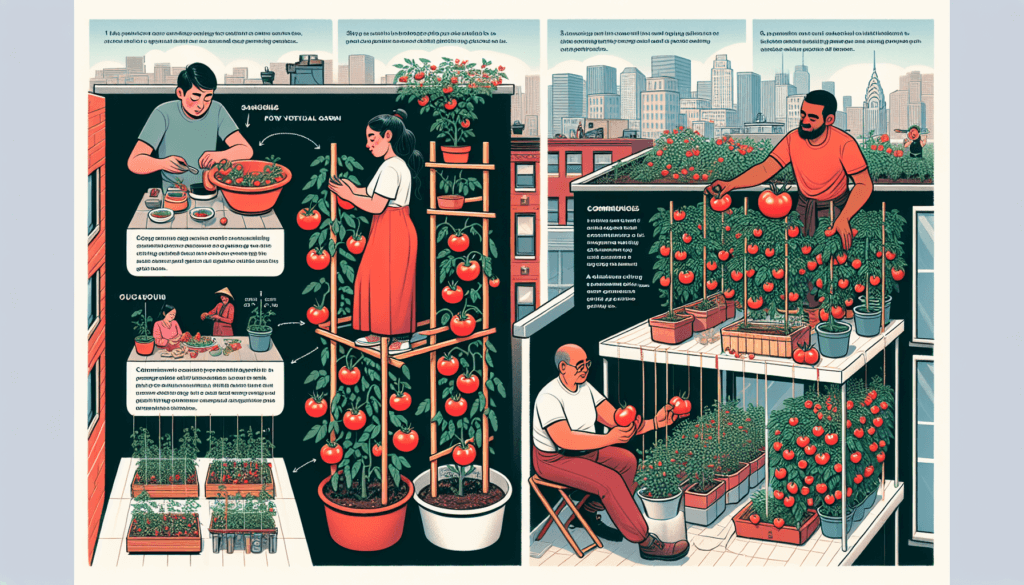Are you a tomato lover who yearns to grow your own juicy, sun-ripened fruits, but live in a bustling urban area devoid of spacious gardens? Fret no more! In this article, we will unveil the best methods for growing tomatoes in an urban setting. From utilizing small patio spaces to vertical gardening techniques, we’ve got you covered on how to cultivate delicious tomatoes right in the heart of the city. So put on your gardening gloves and get ready to discover the secrets to urban tomato success!

Choosing the right tomato variety
When it comes to growing tomatoes in an urban setting, choosing the right variety is essential. There are two main types to consider: determinate and indeterminate varieties. Determinate varieties are typically more compact and have a predetermined height, making them suitable for smaller spaces. On the other hand, indeterminate varieties can grow taller and require more vertical support but tend to produce a higher yield. Consider the space you have available and your preferences when selecting the right tomato variety for your urban garden.
Consider determinate vs. indeterminate varieties
Determinate varieties of tomatoes are often referred to as bush tomatoes. They have a predetermined height and tend to be more compact in nature. This makes them an excellent choice for urban gardens with limited space. Determinate tomatoes usually produce their crop within a short period, making them ideal if you want a large harvest all at once. They are also easier to manage, requiring less pruning and support. Some popular determinate tomato varieties include ‘Roma’, ‘Celebrity’, and ‘Bush Early Girl’.
Indeterminate varieties, on the other hand, are known as vining or climbing tomatoes. These plants continue to grow and produce fruit throughout the entire growing season, making them suitable for urban gardens with vertical support structures such as trellises or cages. The indeterminate tomato plants require regular pruning and support to prevent sprawling growth. Popular indeterminate tomato varieties include ‘Brandywine’, ‘Beefsteak’, and ‘Cherokee Purple’.

Look for compact or dwarf varieties
If space is a concern in your urban garden, compact or dwarf tomato varieties can be a great option. These varieties have been specially bred to have a more compact growth habit while still producing delicious fruits. They are ideal for containers, raised beds, or small garden spaces. Compact or dwarf tomato varieties can be just as prolific and flavorful as their larger counterparts, making them a fantastic choice for urban gardeners. Some popular compact or dwarf tomato varieties to consider are ‘Tiny Tim’, ‘Window Box Roma’, and ‘Tumbler’.
Consider disease-resistant varieties
Diseases can be a significant challenge when growing tomatoes, especially in urban environments where space is limited, and airflow may be restricted. To combat these issues, consider choosing disease-resistant tomato varieties. These varieties have been bred to withstand specific diseases, ensuring a healthier and more productive tomato crop. Look for varieties labeled as resistant to common tomato diseases such as fusarium wilt, verticillium wilt, and tomato mosaic virus. Disease-resistant varieties can help you avoid disappointment and maintain a thriving tomato garden in your urban setting.

Optimizing sunlight exposure
Tomatoes require plenty of sunlight for optimal growth and fruit production. In an urban setting, where buildings and other structures can create shade, it’s crucial to identify the sunniest spots in your garden. Spend some time observing the areas throughout the day to determine which spots receive the most sunlight. This will help you plan where to place your tomato plants for maximum sun exposure.
Identify the sunniest spots in your urban area
Take note of the areas in your urban garden that receive at least 6-8 hours of direct sunlight per day. These spots will provide the ideal conditions for your tomato plants to thrive. Keep in mind that some areas may have varying sunlight exposure throughout the day due to nearby buildings or trees casting shadows. Understanding the sunny spots in your urban area will help you plan your garden layout and make the most of the available sunlight.
Utilize vertical gardening techniques
Vertical gardening can be a game-changer when it comes to optimizing sunlight exposure in an urban setting. By growing your tomatoes vertically, you can take advantage of the vertical space in your garden and ensure each plant receives ample sunlight. Use trellises, stakes, or cages to support your tomato plants and train them to grow upwards. This technique not only maximizes sunlight exposure but also saves valuable ground space, allowing you to grow more tomatoes in a limited area.
Install reflective surfaces to maximize sunlight
Another way to optimize sunlight in your urban garden is by installing reflective surfaces. Consider using white or light-colored materials such as reflective mulch or white-painted walls to bounce sunlight onto your tomato plants. This simple yet effective technique can help increase the amount of light your tomatoes receive and boost their overall growth and productivity. Reflective surfaces can be particularly beneficial if your garden has areas that are partially shaded or receive indirect sunlight.
Selecting suitable containers
Growing tomatoes in containers is an excellent option for urban gardeners with limited space. However, choosing the right containers is crucial to ensure the health and productivity of your tomato plants. Here are some key factors to consider when selecting containers for your urban tomato garden.
Choose containers with good drainage
Proper drainage is essential for container-grown tomatoes to prevent waterlogged roots and the risk of root rot. Look for containers with drainage holes at the bottom to allow excess water to escape. Avoid using containers without drainage holes or those with poor drainage as they can lead to waterlogged soil and unhealthy plants. You can also consider elevating your containers slightly by placing them on bricks or pot feet to further improve drainage.
Consider self-watering containers
In an urban setting where daily watering may not always be practical, self-watering containers can be a convenient option. These containers have a built-in reservoir that holds water, allowing your tomato plants to draw moisture as needed. Self-watering containers can help maintain consistent soil moisture levels, reducing the risk of under or over-watering. They are especially beneficial during hot summer days when plants require more frequent watering.
Use large containers for indeterminate varieties
Indeterminate tomato varieties have a more extensive root system and tend to grow larger overall. Therefore, they require larger containers to accommodate their growth. When growing indeterminate tomatoes in containers, choose pots that have a minimum capacity of 5 gallons. This size will provide enough space for the roots to develop and support the plant’s overall growth. Remember, the larger the container, the more soil it can hold, which translates to better moisture retention and overall plant health.

Preparing the soil
Proper soil preparation is key to providing your tomato plants with the necessary nutrients and growing conditions for healthy growth and abundant fruit production. Here are some essential steps to consider when preparing the soil for your urban tomato garden.
Ensure proper soil drainage
Good soil drainage is crucial for growing healthy tomatoes in an urban setting. Urban environments often consist of compacted soils or heavy clay, which can impede drainage and cause water to pool around the roots. To improve soil drainage, incorporate organic matter such as compost, well-rotted manure, or peat moss into your soil. These amendments help break up compacted soil, allowing excess water to drain freely and preventing waterlogged conditions that can lead to root rot.
Amend the soil with organic matter
Adding organic matter to the soil is beneficial for several reasons. It improves soil structure, enhances moisture retention, and provides essential nutrients to your tomato plants. Organic matter also encourages beneficial microbial activity in the soil, creating a healthy ecosystem for your plants. Mix well-rotted compost or aged manure into the soil before planting your tomatoes to ensure they have access to nutrient-rich soil that promotes vigorous growth.
Test the soil pH and adjust if necessary
Tomatoes prefer slightly acidic soil with a pH range of 6.0 to 6.8. Before planting, it’s a good idea to test the pH level of your soil using a soil testing kit or by sending a sample to a local agricultural extension service. If your soil pH is outside the recommended range, you can adjust it by adding lime to raise the pH or sulfur to lower it. Proper soil pH ensures that nutrients are readily available to your tomato plants, preventing nutrient deficiencies and promoting vibrant growth.
Starting from seeds or seedlings
Tomatoes can be started from either seeds or seedlings. Each method has its advantages, and choosing the one that suits your preferences and garden conditions is essential.
Sowing tomato seeds indoors
Starting tomato seeds indoors allows you to get a head start on the growing season and gives you more control over the plants’ early stages. Begin by selecting a seed starting mix or a well-drained potting mix. Fill seed trays or small pots with the mix and sow the tomato seeds according to the packet instructions. Place the trays or pots in a warm and brightly lit area, such as a sunny windowsill or under grow lights. Keep the soil consistently moist and provide adequate ventilation to prevent mold or damping-off diseases. Once the seedlings have developed their first set of true leaves, you can transplant them into larger containers or your outdoor garden.
Transplanting seedlings outdoors
If you prefer to start with seedlings, you can purchase them from nurseries or garden centers. Look for healthy seedlings with green leaves and robust stems. Before transplanting, harden off the seedlings by gradually acclimating them to outdoor conditions. Start by placing them in a sheltered spot outdoors for a few hours each day, gradually increasing their exposure to sunlight and outdoor temperatures over the course of a week. When the seedlings are ready to be transplanted, dig holes in the garden or prepare containers filled with nutrient-rich soil. Gently remove the seedlings from their pots, being careful not to disturb the roots, and place them in the prepared holes. Firmly press the soil around the seedlings, ensuring they are properly anchored.
Buying healthy seedlings from nurseries
If you don’t want to start from seeds or if you’re looking for specific tomato varieties, buying healthy seedlings from nurseries or garden centers is a convenient option. When selecting seedlings, choose plants that have compact growth and no signs of pests or diseases. Avoid plants with yellowing or spindly stems, as they may be weak or stressed. Healthy seedlings should have vibrant green leaves and sturdy stems. Examine the root system as well, looking for white, robust roots. Buying healthy seedlings will give your tomatoes a head start and increase the likelihood of a successful harvest.

Proper planting techniques
Knowing how to properly plant your tomato seedlings or transplants is crucial for their long-term success. Here are some key considerations when it comes to planting tomatoes in an urban setting.
Digging a hole and removing bottom leaves
Before planting, dig a hole in the soil that is deep enough to accommodate the root system of the seedling or transplant. Gently remove the bottom leaves from the stem, as buried leaves can rot and harbor diseases. The removed leaves should be just above the soil level to prevent stem rot. This allows the plant to focus its energy on root development and overall growth.
Spacing plants correctly
Proper spacing between tomato plants is essential to allow for adequate airflow and prevent the spread of diseases. The specific spacing requirements will vary depending on the tomato variety and its growth habit. Indeterminate varieties generally require more space than determinate varieties. As a general rule of thumb, space determinate tomatoes about 2-3 feet apart and indeterminate tomatoes about 3-4 feet apart. Giving your plants enough space ensures they have room to grow and minimizes competition for nutrients and sunlight.
Burying the stem for stronger root development
One unique planting technique that can benefit tomato plants is burying part of the stem. Tomato plants have the ability to develop roots along the buried portion of the stem, leading to a stronger and more robust root system. After removing the bottom leaves, carefully place the seedling or transplant into the planting hole, making sure the remaining leaves are above the soil level. Gently firm the soil around the stem, ensuring it is securely anchored. The buried stem will develop additional roots, providing better support and nutrient uptake for the entire plant.
Regular watering and moisture maintenance
Tomatoes require consistent moisture for healthy growth and fruit production. Proper watering techniques and moisture maintenance are essential, especially in an urban setting where environmental conditions may vary. Follow these guidelines to ensure optimal water management for your tomato plants.
Water tomato plants deeply and consistently
Water your tomato plants deeply, ensuring the water penetrates deep into the soil. Shallow watering can lead to shallow root growth and make the plants more susceptible to stress during hot weather. Aim to provide about 1 inch of water per week, either through rainfall or irrigation. During dry periods or hot summer months, you may need to water more frequently to keep the soil consistently moist. However, be cautious not to overwater, as this can lead to root rot and other issues. Monitor the soil moisture levels and adjust your watering schedule as needed.
Use mulch to retain moisture
Mulching around your tomato plants can help retain soil moisture and reduce water evaporation. Apply a layer of organic mulch, such as straw, wood chips, or dried leaves, around the base of the plants. Mulch acts as a protective barrier, insulating the soil from extreme temperatures and reducing moisture loss through evaporation. Additionally, mulch helps suppress weed growth, keeping the area around your tomato plants clean and reducing competition for water and nutrients.
Monitor soil moisture levels regularly
Regularly monitoring the soil moisture levels is crucial to ensure your tomato plants receive adequate water. Stick your finger about an inch deep into the soil near the base of the plants. If the soil feels dry at this depth, it’s time to water. Avoid scheduling watering based solely on a fixed timeframe, as environmental factors such as temperature, rainfall, and soil composition can affect moisture retention. By monitoring the soil moisture levels, you can provide the right amount of water when your tomato plants need it most, promoting healthy growth and fruit development.
Fertilizing for optimal growth
Tomatoes are heavy feeders and require regular fertilization to ensure optimal growth and abundant harvests. Consider these tips for fertilizing your urban tomato garden.
Use a balanced slow-release fertilizer
To provide your tomato plants with a steady supply of nutrients, use a balanced slow-release fertilizer. These fertilizers gradually release nutrients over time, ensuring a constant supply for your plants’ needs. Look for a fertilizer with a balanced NPK ratio, such as 10-10-10 or 14-14-14. Apply the fertilizer according to the manufacturer’s instructions, usually spreading it evenly around the base of the plants. Slow-release fertilizers are convenient for urban gardeners as they require fewer applications compared to liquid fertilizers.
Apply organic fertilizers like compost or worm castings
In addition to slow-release fertilizers, incorporating organic fertilizers into your urban tomato garden can provide your plants with valuable nutrients while improving soil health. Organic fertilizers, such as compost, worm castings, or well-rotted manure, add organic matter to the soil and slowly release nutrients as they break down. These natural sources of fertilizer improve soil structure, enhance moisture retention, and promote beneficial microbial activity. Apply organic fertilizers during planting or as a side-dressing throughout the growing season to supply your tomato plants with essential nutrients.
Avoid over-fertilizing to prevent nutrient burn
While fertilizing is important, it’s crucial not to overdo it. Over-fertilizing can lead to nutrient burn, where an excess of nutrients can damage the roots and foliage of your tomato plants. Follow the recommended application rates provided by the fertilizer manufacturer and avoid applying more than necessary. It’s better to under-fertilize slightly and make adjustments based on the specific needs of your plants. Regularly monitor the appearance of your tomato plants, looking for signs of nutrient deficiencies or excesses, and adjust your fertilizer application accordingly.
Pruning and training the plants
Pruning and training your tomato plants are essential practices that help promote healthy growth, enhance airflow, and improve fruit development. These techniques are particularly important in urban settings where space may be limited. Follow these guidelines to properly prune and train your tomato plants.
Remove suckers to promote airflow and control growth
Tomato plants often produce additional shoots, known as suckers, that emerge from the leaf axils. These suckers compete for resources and can result in overcrowding and reduced airflow, increasing the risk of disease. To keep your tomato plants in check, regularly remove the suckers by pinching them off with your fingers or using clean pruning shears. Focus on removing the suckers growing in the leaf axils below the first flower cluster. This practice helps open up the plant, improves airflow, and redirects energy to fruit production.
Use stakes, cages, or trellises for support
Providing proper support for your tomato plants is essential, especially in an urban setting with limited space. Using stakes, cages, or trellises will prevent the plants from sprawling on the ground and make harvesting easier. When using stakes, insert them into the ground near the base of each plant and tie the main stem to the stake using soft plant ties or twine. Cages are ready-made structures that can be placed around the tomato plants at the time of planting. They support the plants as they grow, ensuring they remain upright and preventing branches from breaking under the weight of the fruit. Trellises are another option, particularly for indeterminate tomato varieties, as they offer vertical support for the plants to climb and keep them off the ground.
Pinch off excessive foliage for better fruit development
To promote better fruit development and airflow, it can be beneficial to selectively remove excessive foliage on your tomato plants. Leaves that are low on the plant or shading fruits excessively can be gently removed by pinching them off or using clean pruning shears. This practice allows more sunlight to reach the fruit and promotes better air circulation, reducing the risk of diseases. However, be careful not to remove too much foliage, as the leaves play a crucial role in photosynthesis and energy production for the plant. Strike a balance between foliage removal and maintaining a healthy photosynthetic capacity.
Pest and disease management
Dealing with pests and diseases is a common challenge when growing tomatoes, especially in urban environments where conditions may be favorable for their development. Implementing proper pest and disease management techniques can help protect your tomato plants and ensure a successful harvest.
Identify common tomato pests and their control methods
Tomatoes can be attacked by various pests, including aphids, caterpillars, whiteflies, and tomato hornworms. Monitor your plants regularly for signs of pest activity, such as holes in leaves, distorted growth, or sticky residue. If pests are detected, consider using targeted organic pest control methods such as handpicking, applying insecticidal soaps or oils, or using biological controls like beneficial insects. In urban settings, it’s important to address pest issues promptly to prevent infestations from spreading to neighboring gardens.
Prevent diseases through proper sanitation and spacing
Diseases, such as early blight, late blight, and powdery mildew, can be a significant threat to tomato plants. To prevent disease outbreaks, practice good sanitation and spacing techniques. Remove and destroy any infected plant debris, including fallen leaves or fruits, to prevent the buildup of pathogens. Ensure proper spacing between plants to allow for good airflow and reduce the chances of disease transmission. Water at the base of the plants, avoiding overhead irrigation, as wet foliage can contribute to disease development. Additionally, avoid working with your tomato plants when they are wet, as this can spread diseases.
Consider natural pest control methods before resorting to chemicals
When faced with pest or disease issues, consider using natural pest control methods before turning to chemical solutions. There are several organic options available, such as insecticidal soaps, horticultural oils, neem oil, or biological controls like ladybugs or nematodes. These natural methods are effective in controlling pests without harming beneficial insects or the environment. By using natural pest control methods, you can maintain a healthier and more balanced ecosystem in your urban tomato garden.
Growing tomatoes in an urban setting can be a rewarding and enjoyable experience. By choosing the right tomato variety, optimizing sunlight exposure, selecting suitable containers, preparing the soil properly, starting from seeds or seedlings, employing proper planting techniques, maintaining regular watering and moisture levels, fertilizing appropriately, pruning and training the plants, and effectively managing pests and diseases, you can grow a thriving and productive tomato garden in your urban space. So gather your tools, roll up your sleeves, and get ready to enjoy the freshest and most delicious tomatoes straight from your own urban garden!


